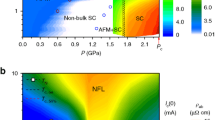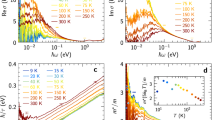Abstract
In cuprate superconductors, a pronounced maximum of superconducting \({T}_{c}^{max}\) is observed in compounds that have an in-plane Cu–O distance \({a}_{Cu-O}\) close to \(\sim 1.92\) angstroms. On the other hand, direct measurements of the electron–phonon coupling \(\lambda \langle {\omega }^{2}\rangle\) as a function of \({a}_{Cu-O}\) show a clear linear correlation, implying that \({T}_{c}^{max}\) is a strongly non-linear function of \(\lambda \langle {\omega }^{2}\rangle\). Conventional superconductivity theories based on the electron–phonon interaction predict a monotonic dependence of \({T}_{c}^{max}\) on \(\lambda \langle {\omega }^{2}\rangle\), which makes them incompatible with the observed behavior. The observed crossover behavior as a function of \(\lambda \langle {\omega }^{2}\rangle\) suggests that \({T}_{c}^{max}\) occurs at the crossover from weak to strong coupling, which is also associated with the onset of carrier localization. A coexistence, with a dynamical exchange of localized and itinerant carriers in a two-component superconductivity scenario are in agreement with the observed anomalous behavior and are suggested to be the key to understanding the mechanism for achieving high \({T}_{c}^{max}\).


Similar content being viewed by others
References
Batlogg, B.: Isotope Effect in the High-Tc Superconductors Ba2YCu3O7 and Ba2EuCu307 Phys. Rev. Lett. 58, 2333 (1987)
Bussmann-Holder, A., Keller, H.: Unconventional Isotope Effects, Multi-Component Superconductivity and Polaron Formation in High Temperature Cuprate Superconductors. J Phys. Conf. Ser. 108, 012019 (2008)
Drozdov, A.P., Kong, P.P., Minkov, V.S., Besedin, S.P., Kuzovnikov, M.A., Mozaffari, S., Balicas, L., Balakirev, F.F., Graf, D.E., Prakapenka, V.B., Greenberg, E., Knyazev, D., Tkacz, M., Eremets, M.I.: Superconductivity at 250 K in Lanthanum Hydride under High Pressures Nature 569, 528 (2019)
McMillan, W.L.: Transition Temperature of Strong-Coupled Superconductors. Phys. Rev. 167, 331 (1968)
Eliashberg, G.M.: Interactions between Electrons and Lattice Vibrations in a Superconductor. Sov. Phys. JETP 11, 696 (1960)
Rao, C.N.R., Ganguli, A.K.: Structure-Property Relationship in Superconducting Cuprates. Chem. Soc. Rev. 24, 1 (1995)
Gadermaier, C., Kabanov, V.V., Alexandrov, A.S., Mihailovic, D.: Strain-Induced Enhancement of the Electron Energy Relaxation in Strongly Correlated Superconductors. Phys. Rev. X 4, 011056 (2014)
Allen, P.B.: Theory of Thermal Relaxation of Electrons in Metals Phys. Rev. Lett. 59, 1460 (1987)
Kabanov, V.V., Alexandrov, A.S.: Electron Relaxation in Metals: Theory and Exact Analytical Solutions. Phys. Rev. B 78, 174514 (2008)
Feynman, R.P.: Slow Electrons in a Polar Crystal. Phys. Rev. 97, 660 (1955)
Micnas, R., Ranninger, J., Robaszkiewicz, S.: Superconductivity in Narrow-Band Systems with Local Nonretarded Attractive Interactions. Rev. Mod. Phys. 62, 113 (1990)
Alexandrov, A., Ranninger, J.: Theory of Bipolarons and Bipolaronic Bands. Phys. Rev. B 23, 1796 (1981)
Robaszkiewicz, S., Micnas, R., Ranninger, J.: Superconductivity in the Generalized Periodic Anderson Model with Strong Local Attraction. Phys. Rev. B 36, 180 (1987)
Mihailovic, D., Müller, D.A.: The Two-Component Paradigm for Superconductivity in the Cuprates, in High-Tc Superconductivity 1996: Ten Years after the Discovery, Eds. E. Kaldis, E. Liarokapis and K.A.Muller, NATO ASI Series (NSSE) 343, 243–256 (1997)
Mihailovic, D., Foster, C.M., Voss, K., Heeger, A.J.: Application of the Polaron-Transport Theory to σ(ω) in Tl2Ba2Ca1-XGdxCu2O8, YBa2Cu3O7- d, and La2-XSrxCuO4. Phys. Rev. B 42, 7989 (1990)
Thomas, T.N., Stevens, C.J., Choudhary, A., Ryan, J.F., Mihailovic, D., Mertelj, T., Forro, L., Wagner, G., Evetts, J.E.: Photoexcited Carrier Relaxation and Localization in Bi2Sr2Ca1-YYyCu2O8 and YBa2Cu3O7: A Study by Femtosecond Time-Resolved Spectroscopy. Phys. Rev. B 53, 12436 (1996)
Madan, I., Kurosawa, T., Toda, Y., Oda, M., Mertelj, T., Mihailovic, D.: Evidence for Carrier Localization in the Pseudogap State of Cuprate Superconductors from Coherent Quench Experiments. Nat. Commun. 6, 6958 (2015)
Mihailovic, D., Stevens, C., Demsar, J., Podobnik, B., Smith, D., Ryan, J.: Evidence for Polarons and Itinerant Carriers in Superconductivity from Time-Resolved Optical Measurements on YBa2Cu3O. J. Supercond. 10, 337 (1997)
Stevens, C.J., Smith, D., Chen, C., Ryan, J.F., Podobnik, B.: Evidence for Two-Component High-Temperature Superconductivity in the Femtosecond Optical Response of YBa2Cu3O7- δ. Phys. Rev. Lett. 78, 2212 (1997)
Mertelj, T., Demsar, J., Podobnik, B., Poberaj, I., Mihailovic, D.: Photoexcited Carrier Relaxation in YBaCuO by Picosecond Resonant Raman Spectroscopy. Phys. Rev. B 55, 6061 (1997)
Mertelj, T., Kabanov, V., Mihailovic, D.: Charged Particles on a Two-Dimensional Lattice Subject to Anisotropic Jahn-Teller Interactions. Phys. Rev. Lett. 94, 147003 (2005)
Mertelj, T., Kabanov, V.V., Mena, J.M., Mihailovic, D.: Self-Organization of Charged Particles on a Two-Dimensional Lattice Subject to Anisotropic Jahn-Teller-Type Interaction and Three-Dimensional Coulomb Repulsion. Phys Rev B 76, 9 (2007)
Fischer, O., Kugler, M., Maggio-Aprile, I., Berthod, C., Renner, C.: Scanning Tunneling Spectroscopy of High-Temperature Superconductors. Rev. Mod. Phys. 79, 353 (2007)
Mihailovic, D., Kabanov, V., Muller, K.: The Attainable Superconducting T-c in a Model of Phase Coherence by Percolating. Europhys. Lett. 57, 254 (2002)
Miranda, J., Mertelj, T., Kabanov, V.V., Mihailovic, D.: Bipolaron Jahn-Teller Pairing and Charge Transport in Cuprates. Journal Of Superconductivity And Novel Magnetism 22, 281 (2009)
Mihailovic, D., Inter-Site Pair Superconductivity: Origins and Recent Validation Experiments. Springer Series: Mat. Sci. 201 (2017)
Mertelj, T., Kabanov, V.V., Mihailovic, D.: Charged Particles on a Two-Dimensional Lattice Subject to Anisotropic Jahn-Teller Interactions. Phys Rev Lett 94, 147003 (2005)
Acknowledgements
On this special occasion of his 95th birthday, I wish to acknowledge K. Alex Müller for continuing inspiration, valuable discussions and encouragement over the years that kept me working in this remarkable field for such a long time. I also wish to acknowledge V.V. Kabanov and T. Mertelj for contributions to the presented and cited work.
Author information
Authors and Affiliations
Corresponding author
Additional information
Publisher's Note
Springer Nature remains neutral with regard to jurisdictional claims in published maps and institutional affiliations.
Rights and permissions
About this article
Cite this article
Mihailovic, D. Why Does Maximum Tc Occur at the Crossover From Weak to Strong Electron–phonon Coupling in High-temperature Superconductors?. J Supercond Nov Magn 35, 1769–1773 (2022). https://doi.org/10.1007/s10948-022-06152-5
Received:
Accepted:
Published:
Issue Date:
DOI: https://doi.org/10.1007/s10948-022-06152-5




